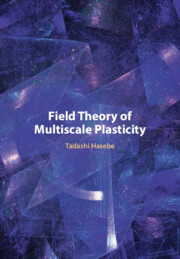Book contents
- Field Theory of Multiscale Plasticity
- Field Theory of Multiscale Plasticity
- Copyright page
- Contents
- Preface
- Acknowledgments
- Part I Fundamentals
- Part II Theoretical Backgrounds
- Part III Applications I
- Part IV Applications II
- 13 Cooperation of Multiple Inhomogeneous Fields
- 14 Outlooks
- 15 Flow-Evolutionary Law as a Working Hypothesis
- References
- Author Index
- Subject Index
15 - Flow-Evolutionary Law as a Working Hypothesis
from Part IV - Applications II
Published online by Cambridge University Press: 14 December 2023
- Field Theory of Multiscale Plasticity
- Field Theory of Multiscale Plasticity
- Copyright page
- Contents
- Preface
- Acknowledgments
- Part I Fundamentals
- Part II Theoretical Backgrounds
- Part III Applications I
- Part IV Applications II
- 13 Cooperation of Multiple Inhomogeneous Fields
- 14 Outlooks
- 15 Flow-Evolutionary Law as a Working Hypothesis
- References
- Author Index
- Subject Index
Summary
The completion of the theory for MMMs (multiscale modeling of materials) is manifested itself partially as an identification of the right “flow-evolutionary” law explicitly, which describes generally the evolution of the inhomogeneous fields and the attendant local plastic flow accompanied by energy dissipation. The notion “duality” ought to be embodied by this law, although it still is a “working hypothesis,” deserving further investigations. Specifically, it represents the interrelationship between the locally stored strain energy and the local plastic flow as has been discussed in the context of polycrystalline plasticity in Chapter 12 for Scale C. In this final chapter, we will derive explicitly a candidate form of the flow-evolutionary law as a possible embodiment of the duality, which is followed by application examples.
Keywords
- Type
- Chapter
- Information
- Field Theory of Multiscale Plasticity , pp. 774 - 808Publisher: Cambridge University PressPrint publication year: 2024

